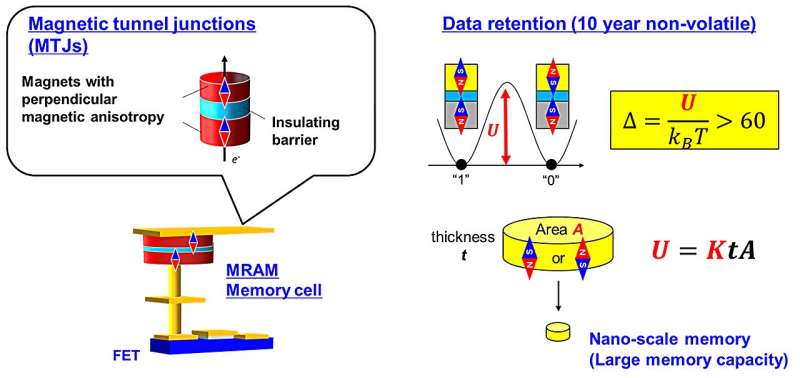
December 27, 2024 by Tohoku University
Collected at: https://phys.org/news/2024-12-spintronics-memory-perpendicular-magnetized.html
Long gone are the days where all our data could fit on a two-megabyte floppy disk. In today’s information-based society, the increasing volume of information being handled demands that we switch to memory options with the lowest power consumption and highest capacity possible.
Magnetoresistive Random Access Memory (MRAM) is part of the next generation of storage devices expected to meet these needs. Researchers at the Advanced Institute for Materials Research (WPI-AIMR) investigated a cobalt-manganese-iron alloy thin film that demonstrates a high perpendicular magnetic anisotropy (PMA)—key aspects for fabricating MRAM devices using spintronics.
The findings were published in Science and Technology of Advanced Materials on November 13, 2024.
“This is the first time a cobalt-manganese-iron alloy has strongly shown large PMA,” says Professor Shigemi Mizukami (Tohoku University),
“We previously discovered this alloy showed a high tunnel magnetoresistance (TMR) effect, but it is rare that an alloy potentially shows both together.” For example, iron-cobalt-boron alloys, which are conventionally used for MRAM, possess both traits, but their PMA is not strong enough.
MRAM devices use magnetic storage elements instead of an electric charge to store data, which gives it several advantages such as reduced power consumption. Ideally, alloys for MRAM devices have both a high TMR and PMA, which allow them to integrate a large number of bits with high capacity and high thermal stability.
 Numerical simulation suggested that the Co-Mn-Fe multilayer films with PMA show the large thermal stability factors delta exceeding 60 even in nano scale, which can be used for 10 nm scale MRAM. Credit: D. Kumar et al. (The data is used from D. Kumar et al. Science and Technology of Advanced Materials, 25 (1), 2421746 (2024).)
Numerical simulation suggested that the Co-Mn-Fe multilayer films with PMA show the large thermal stability factors delta exceeding 60 even in nano scale, which can be used for 10 nm scale MRAM. Credit: D. Kumar et al. (The data is used from D. Kumar et al. Science and Technology of Advanced Materials, 25 (1), 2421746 (2024).) We demonstrated high TMR effect, which is prerequisite for MRAM, using novel metastable body-centered cubic (bcc) Co-Mn-Fe in a previous report [T. Ichinose et al. Journal of Alloys and Compounds 960, 170750 (2023). In this work, we demonstrated large perpendicular magnetic anisotropy (PMA) which can originate from the lattice strain. Credit: D. Kumar et al. (Part of the data is used from D. Kumar et al. Science and Technology of Advanced Materials, 25 (1), 2421746 (2024).
We demonstrated high TMR effect, which is prerequisite for MRAM, using novel metastable body-centered cubic (bcc) Co-Mn-Fe in a previous report [T. Ichinose et al. Journal of Alloys and Compounds 960, 170750 (2023). In this work, we demonstrated large perpendicular magnetic anisotropy (PMA) which can originate from the lattice strain. Credit: D. Kumar et al. (Part of the data is used from D. Kumar et al. Science and Technology of Advanced Materials, 25 (1), 2421746 (2024).
In order to find new, alternative materials to solve the issues seen with currently used alloys, researchers at Tohoku University have investigated the PMA of cobalt-manganese-iron alloy thin films, which were shown to have high TMR in their previous research.
Remarkably, the alloy they produced was found to exhibit high PMA. They also demonstrated that the PMA in their multilayer films was large enough to be capable of its intended end purpose: large memory capacity for MRAM devices using a simulation.
The results of this research will offer a new candidate for memory materials, and contribute to the continuous development of novel spintronics memory devices, with the aim of creating a more sustainable society for everyone.
More information: Deepak Kumar et al, Metastable body-centered cubic CoMnFe alloy films with perpendicular magnetic anisotropy for spintronics memory, Science and Technology of Advanced Materials (2024). DOI: 10.1080/14686996.2024.2421746
Journal information: Science and Technology of Advanced Materials

Leave a Reply